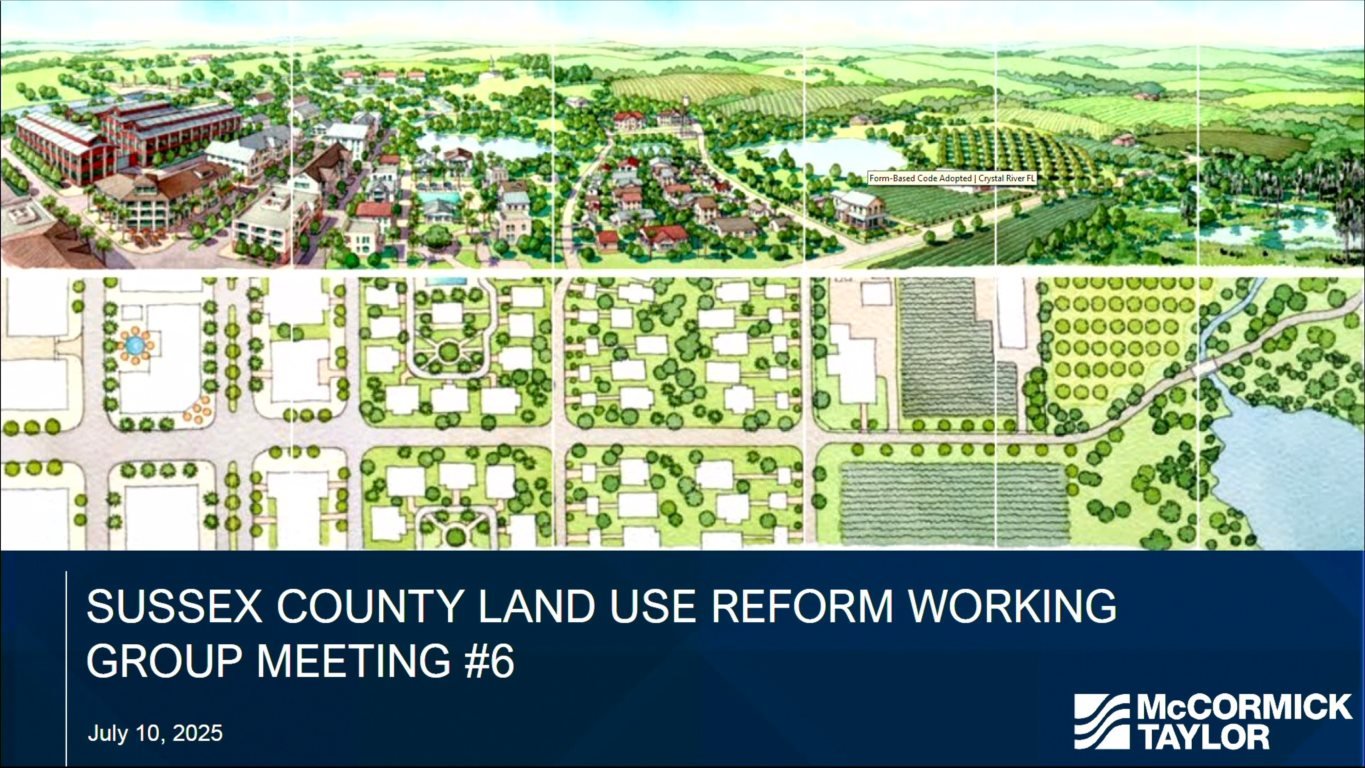On July 10th, the Sussex County Land Use Reform Working Group met to continue shaping their packet of draft recommendations in order to sustain the future of growth, development, and preservation in Coastal Delaware through its development.
The session covered a wide range of land use issues, from rural zoning and growth zone density to funding for infrastructure and open space protection.
Here’s a brief look at some of the key topics & ideas around the recommendations discussed in the meeting:
The List : 22 Draft Recommendations
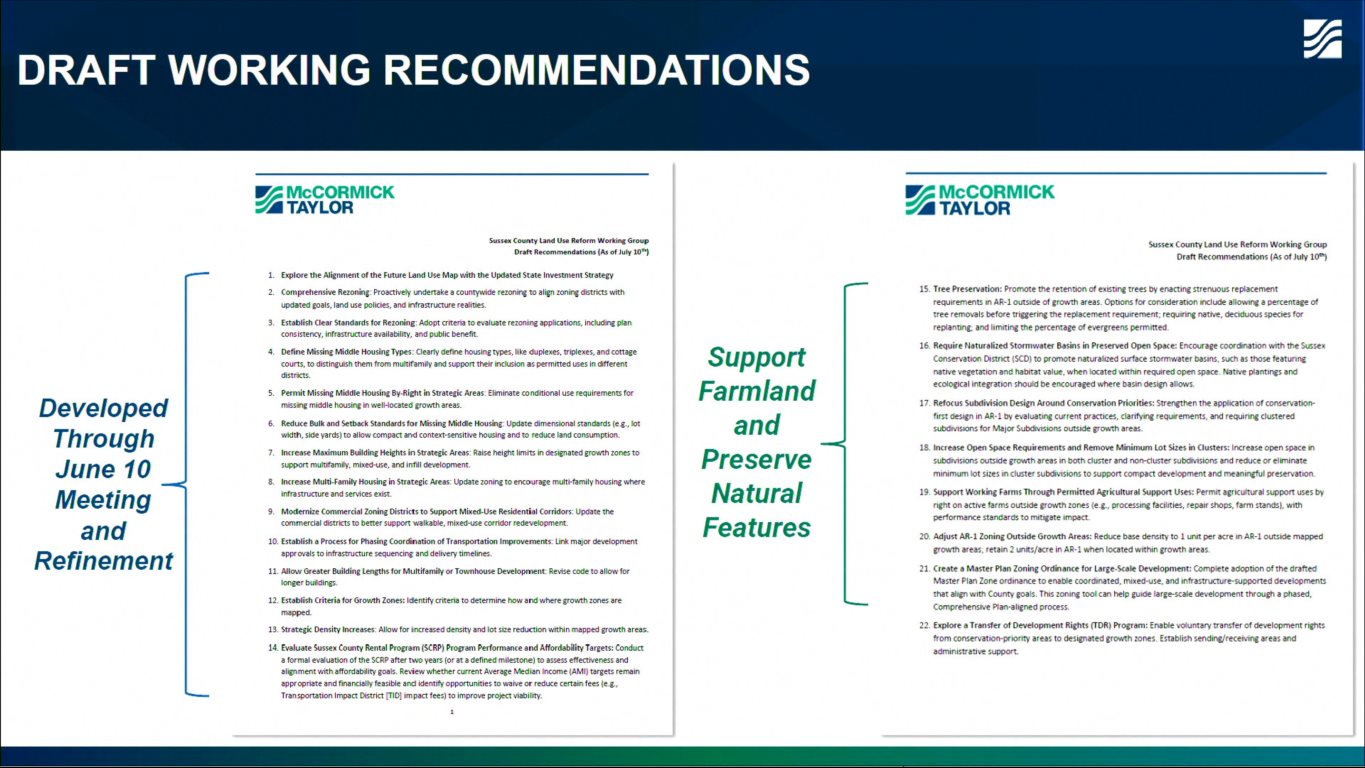
The Land Use Reform Working Group has assembled a robust list of 22 draft recommendations that reflect months of discussion, feedback, research, and public input.
The strategies touch on a wide range of planning & implementation goals, focusing mainly around three key ideas: guiding growth to the right places, protecting rural and natural areas, and increasing the availability of housing options while maintaining the character of established local communities.
While some of the recommendations were expanded upon later in the meeting, several important items stood out during the initial overview, including:
- Aligning the Future Land Use Map with the State Investment Strategy to ensure that county-level planning is consistent with statewide infrastructure and preservation priorities.
- Adopting Clear Standards for Rezoning, including consistency with the Comprehensive Plan, infrastructure capacity, and public benefit.
- Modernizing Commercial Zoning Districts to support walkable, mixed-use residential corridors and redevelop aging commercial areas.
- Evaluating the Sussex County Rental Program (SCRP) to assess its affordability targets, financial feasibility, and effectiveness after implementation.
- Establishing Criteria for Growth Zones to help identify where growth should occur and under what conditions.
These items are designed with the intention when implemented to provide a more predictable, transparent, and infrastructure-aware framework for land use decisions in Sussex County.
Tree Preservation: From Requirements to Stronger Recommendations
Recommendation #15 from the draft list states the following: "Promote the retention of existing trees by enacting strenuous replacement requirements in AR-1 outside of growth areas. Options for consideration include allowing a percentage of tree removals before triggering the replacement requirement; requiring native, deciduous species for replanting; and limiting the percentage of evergreens permitted."
Tree preservation was one of the first recommendations talked about early on in this meeting, with participants discussing the growing gap between what’s currently required and what community members believe should be done.
While Sussex County’s current code already includes some preservation language, speakers pointed out that it often lacks clarity and isn’t always enforced effectively.
Discussion highlights included:
- Current code: Tree buffers and preservation areas are technically required in some development plans, but the rules are often seen as vague or easy to bypass.
- On-the-ground reality: Developers frequently clear-cut lots despite existing guidelines, leading to frustration among residents and local planners.
- Recommendations: There was overall pushing for the value of old growth (or original trees in forest areas) versus newly planted trees once lots are cleared, with potentiality of incentivizing plans that preserve original growth forests and mature trees. The group discussed a stronger code with clearer language, better enforcement, and incentives for developers who preserve mature trees. Suggestions from members during discussion also included requiring native species in replanting and considering establishing minimum tree cover standards.
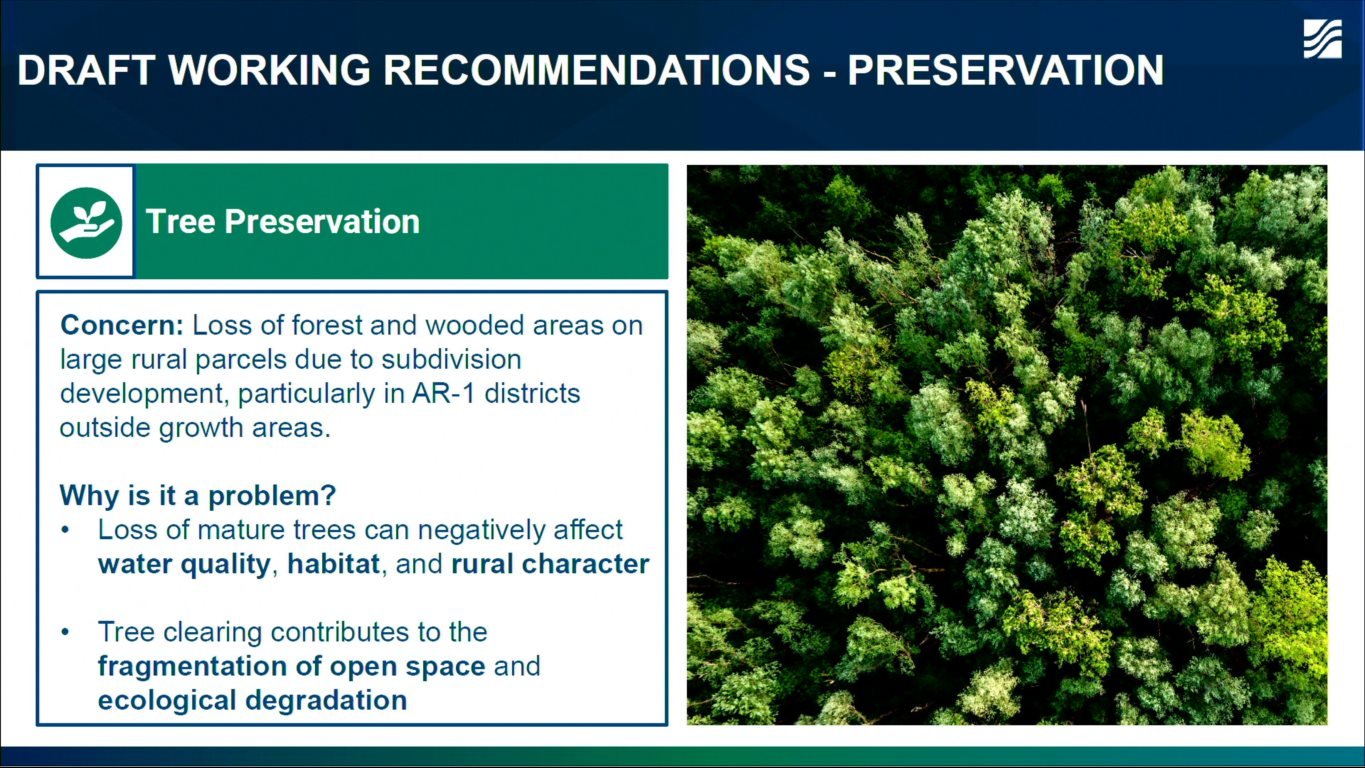
Designing Subdivisions Around Conservation Priorities
Recommendation #17 from the draft list states the following: "Strengthen the application of conservation-first design in AR-1 by evaluating current practices, clarifying requirements, and requiring clustered subdivisions for Major Subdivisions outside growth areas."
Midway through the meeting, the group examined how subdivision design could better reflect the county’s conservation goals, especially in protected or ecologically sensitive areas.
Currently, many subdivisions are laid out in a way that ignores the landscape’s natural features, leading to environmental strain and inefficient land use.
Participants emphasized that subdivision layouts should begin with conservation priorities in mind, identifying areas for protection before housing lots are drawn.
There was strong support for cluster development, where homes are grouped more densely in certain areas to leave larger portions of the land undeveloped and intact.
Speakers also stressed the importance of requiring developers to identify high-priority conservation areas during the earliest stages of site planning.
Open Space Requirements: What’s Already in Place and What’s Recommended
Recommendation #18 from the draft list reflects the following: "Increase open space in subdivisions outside growth areas in both cluster and non-cluster subdivisions and reduce or eliminate minimum lot sizes in cluster subdivisions to support compact development and meaningful preservation."
The working group devoted time in the July 10th meeting to Sussex County’s open space requirements, highlighting what’s already been addressed and what still needs action.
Under Ordinance No. 3062, adopted in December 2024, the county now requires developers to set aside a certain percentage of open space depending on project density.
Projects with 2 to 5 units per acre must dedicate 10% of the land as open space. For developments with 6 to 10 units per acre, the requirement rises to 15%. Anything above 10 units per acre must set aside 25%.
These open spaces must also meet minimum standards to qualify. They must be contiguous and connected; small, isolated pockets of land—anything under 10,000 square feet—don’t count toward the total.
However, while these updates represent meaningful progress, the group noted that more work remains.
During the meeting they outlined what counts as usable open space—such as trails, buffers, and community parks—and what does not, including isolated strips of land or leftover parcels wedged between roads and parking lots.
The goal with this recommendation being included is to ensure open space has true environmental or recreational value for meaningful preservation efforts for all residents, locals, and visitors.
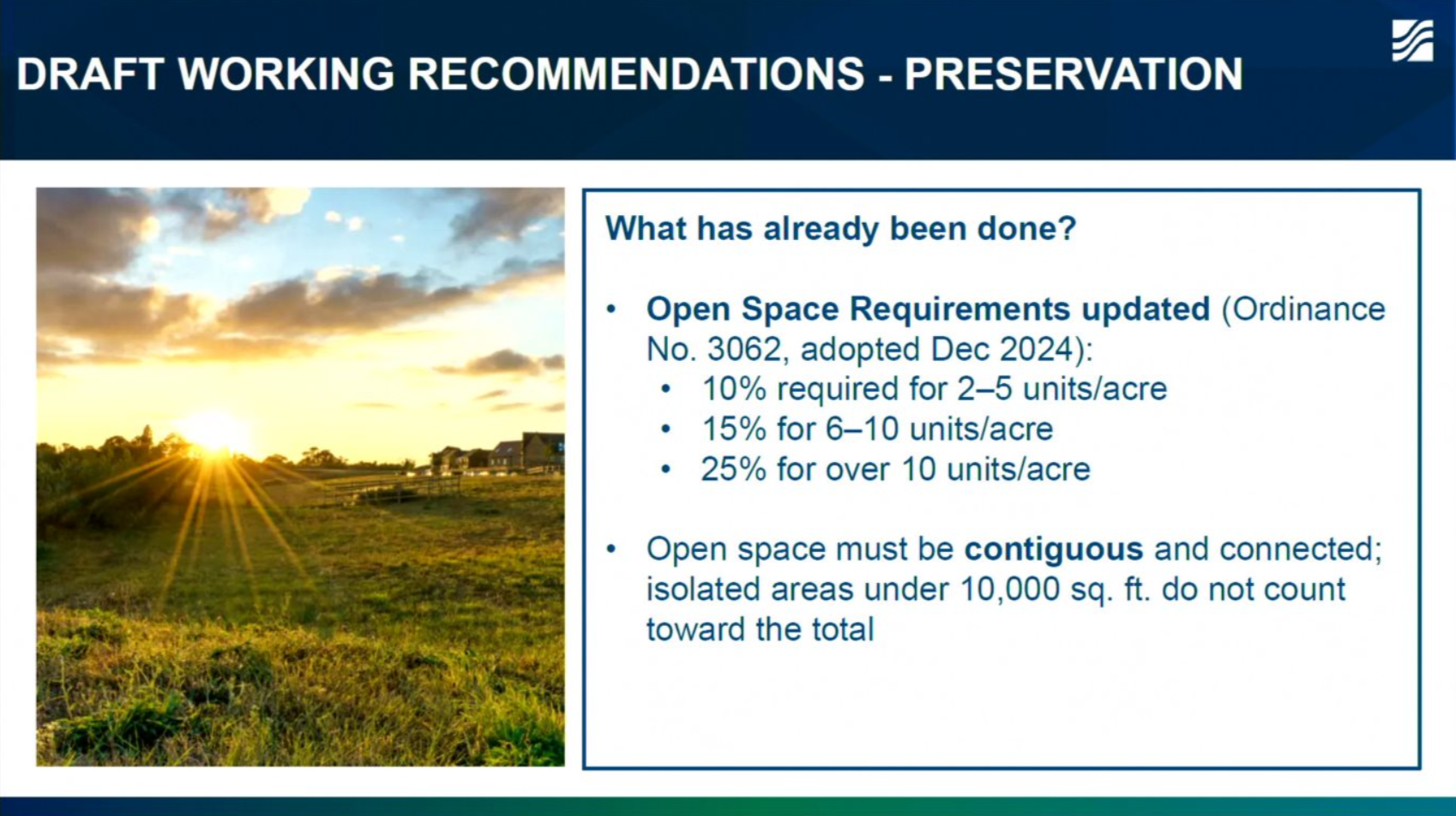
Zoning Reforms: Different Rules Inside and Outside Growth Zones
Recommendation #20 from the draft list says: "Reduce base density to 1 unit per acre in AR-1 outside mapped growth areas; retain 2 units/acre in AR-1 when located within growth areas."
One of the biggest conversations of this session was how to adjust zoning rules in the county’s Agricultural Residential (AR-1) areas.
- Outside growth zones: The group leaned toward reducing density to 1 unit per acre to help preserve Sussex County’s rural character, open space, and farmland.
- Inside growth zones: There was broad support for increasing density to at least 2 units per acre, making it easier to build townhomes, multifamily units, and affordable housing where infrastructure is already in place.
- There was added notion to consider future rezoning to reinforce this differentiation over time
Members stressed that clearly defining where growth should go, and where it shouldn’t, is critical to the county’s future and how we should move forward.
Streamlining Approvals Within Growth Zones
Following the conversation about zoning reforms, the group emphasized the need to streamline the approval process for development proposals within designated growth areas.
The consensus was that if a proposed project aligns with existing zoning and complies with all relevant requirements, it should be processed more efficiently, potentially without requiring lengthy public hearings.
This approach aims to cut down on unnecessary delays, reduce development costs, and give builders greater certainty.
By removing barriers to development in areas where infrastructure already exists or is planned, Sussex County can more effectively steer growth toward appropriate locations, instead of allowing it to sprawl into rural areas.
The broader goal is to create a system where responsible development is not only allowed, but actively encouraged, as long as it fits the county’s long-term land use vision.
This is highlighted in Recommendation #13 from the draft list: "Allow for increased density and lot size reduction within mapped growth areas."
Housing Options: More Flexibility, More Affordability
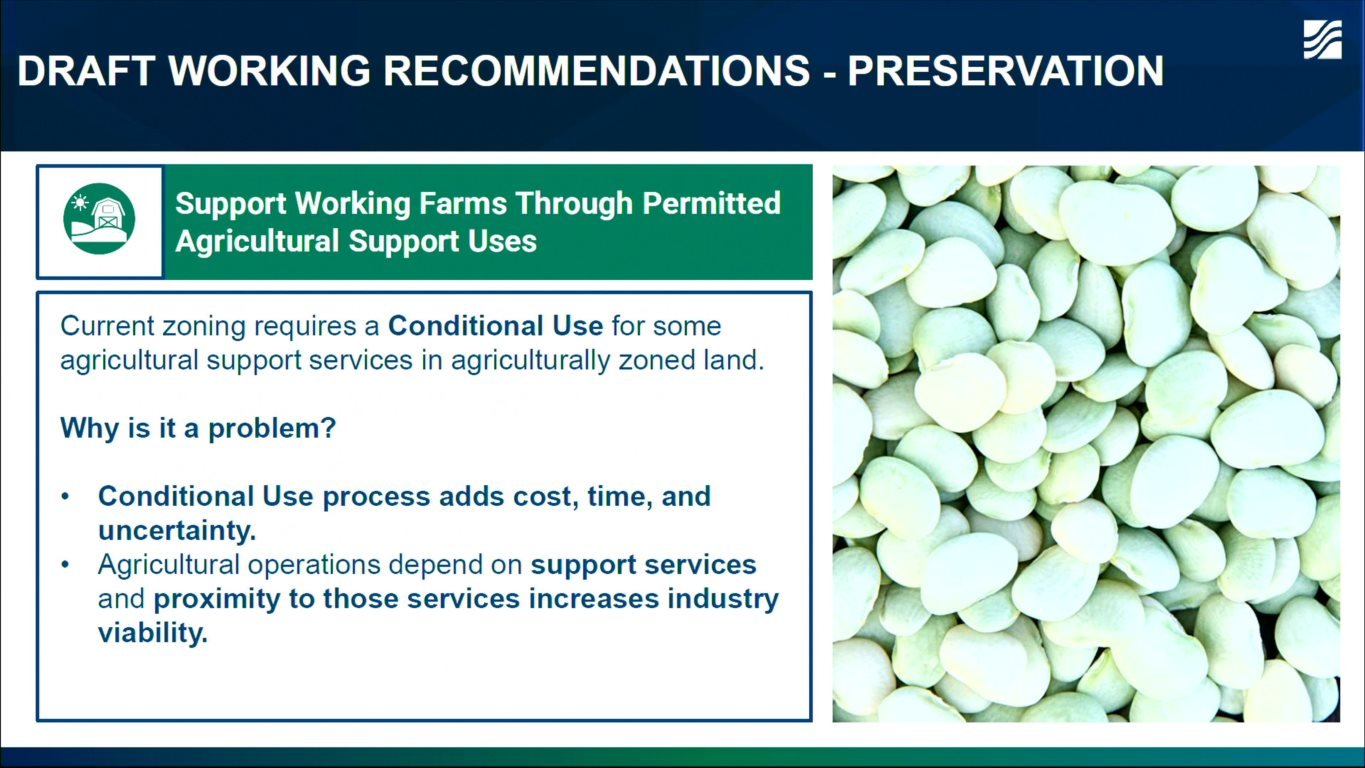
To address the housing shortage and rising costs, the group discussed encouraging a wider mix of housing types within growth zones, including:
- Cottage courts
- Duplexes
- Townhomes
- Smaller-lot single-family homes
The idea is to create more attainable housing options while still protecting the county’s rural areas from unchecked sprawl.
This discussion aligns with three recommendations from the draft list and you can find these items below:
Recommendation #4: "Clearly define housing types, like duplexes, triplexes, and cottage courts, to distinguish them from multifamily and support their inclusion as permitted uses in different districts."
Recommendation #5: "Eliminate conditional use requirements for missing middle housing in well-located growth areas."
Recommendation #6: "Update dimensional standards (e.g., lot width, side yards) to allow compact and context-sensitive housing and to reduce land consumption."
The topic was also discussed in greater depth during a previous meeting on June 12th, you can check all the details here.
Master Plan Zoning For Mixed Use Large Scale Development
Recommendation #21 from the draft list says: "Complete adoption of the drafted Master Plan Zone ordinance to enable coordinated, mixed-use, and infrastructure-supported developments that align with County goals. This zoning tool can help guide large-scale development through a phased, Comprehensive Plan-aligned process."
This was another time intensive topic for this timeframe, being the county’s Master Plan zoning ordinance.
The ordinance has already been drafted, and the framework is fully written, laying the groundwork for future implementation if proceeded with ambition to be used & approved.
This planning tool is designed to:
- Encourage walkable, mixed-use communities
- Allow large developments to be built in phases, aligned with infrastructure
- Provide flexibility in housing type and layout
- Be restricted to designated growth zones
Although much of the foundational work is complete, the ordinance has not yet been adopted. The group urged county officials to take the next step and move forward with steps towards formal adoption.
Rethinking Transfer of Development Rights
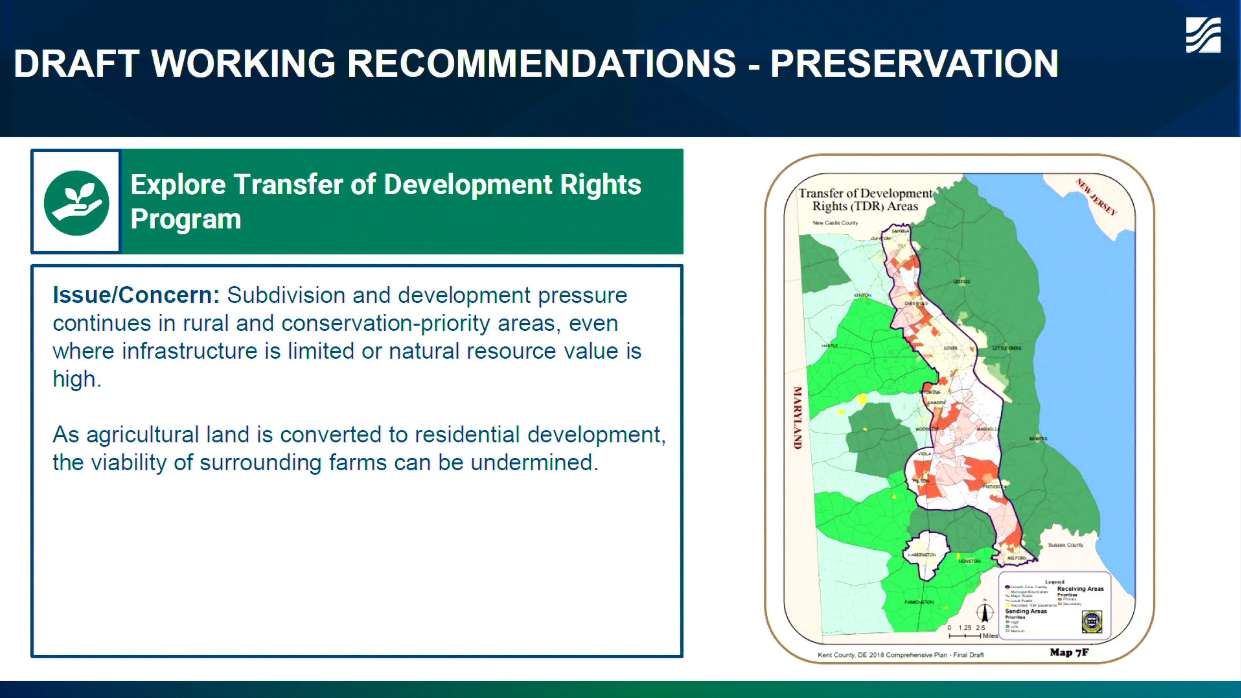
A portion of the July 10th meeting, as well as the previous meeting on June 12th, focused on the potential for a Transfer of Development Rights (TDR) program as a tool for land preservation.
Recommendation #22 from the draft list shows as follows: "Enable voluntary transfer of development rights from conservation-priority areas to designated growth zones. Establish sending/receiving areas and administrative support."
While the concept is not new, the group acknowledged that traditional TDR programs have often failed due to their rigid structure and lack of clear incentives.
The discussion emphasized that Sussex County must develop a tailored, Sussex-specific version of a TDR program if we really want to preserve spaces at scale.
Group members noted that the conventional model often creates a system of “winners and losers,” where some landowners benefit from selling their development rights, while others are left without viable options. This has made buy-in and participation thoughts to be uneven at best.
To address these concerns, the group proposed a framework centered on flexibility and funding. Instead of relying solely on permanent conservation easements, which are difficult to secure, they suggested offering shorter-term options — such as 10-to-15-year easements — which may appeal to more landowners overall.
Additionally, a “density buy” system was floated, allowing developers to increase unit counts within growth zones by contributing financially to preservation efforts elsewhere.
This concept hinges on a clear compensation mechanism: landowners who give up development rights must be fairly paid, and developers need to see real value in participating.
The goal is to avoid a zero-sum structure and create a functioning market where preservation and growth can coexist.
The group ultimately recommended a deeper evaluation of whether Sussex County could successfully implement a revised TDR program, and how it could be funded and administered to benefit both rural preservation and smart development planning.
What’s Next for the Sussex County Land Use Reform Group?
During public comment, a member of the public also emphasized the need for transparency and accountability, urging the group to follow through with meaningful action rather than producing recommendations that go nowhere.
The working group has already met again back on July 24th, and the next meetings are scheduled for:
- August 5th, 2025
- August 21st, 2025
Altogether, the draft recommendations reflect a comprehensive approach that balances smart growth with land preservation, affordability, and infrastructure planning.
While none of the proposals are final, they mark a pivotal step toward a more strategic and sustainable land use framework for Sussex County.
Want to know how Sussex County is changing, and how you can have a voice? Follow our blog for updates on upcoming meetings, land use changes, and ways to get involved in shaping the future of Coastal Delaware!
All referenced documents and details from our blog can be found through meeting notes / materials that are available through Sussex County’s official website, and public meeting minutes & broadcasts archive.
Source: Sussex County, Draft Recommendations List

